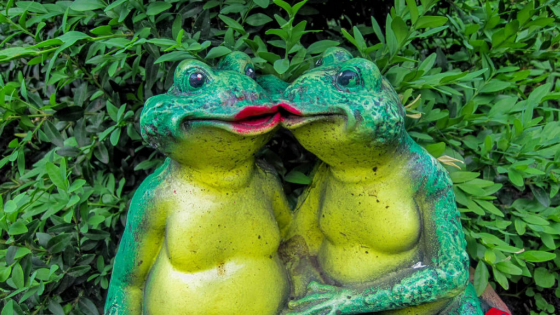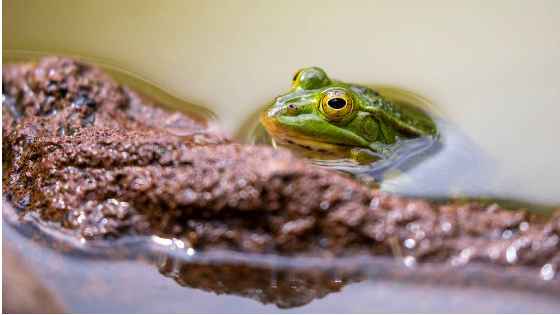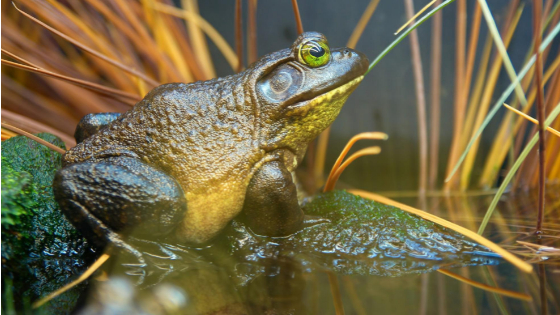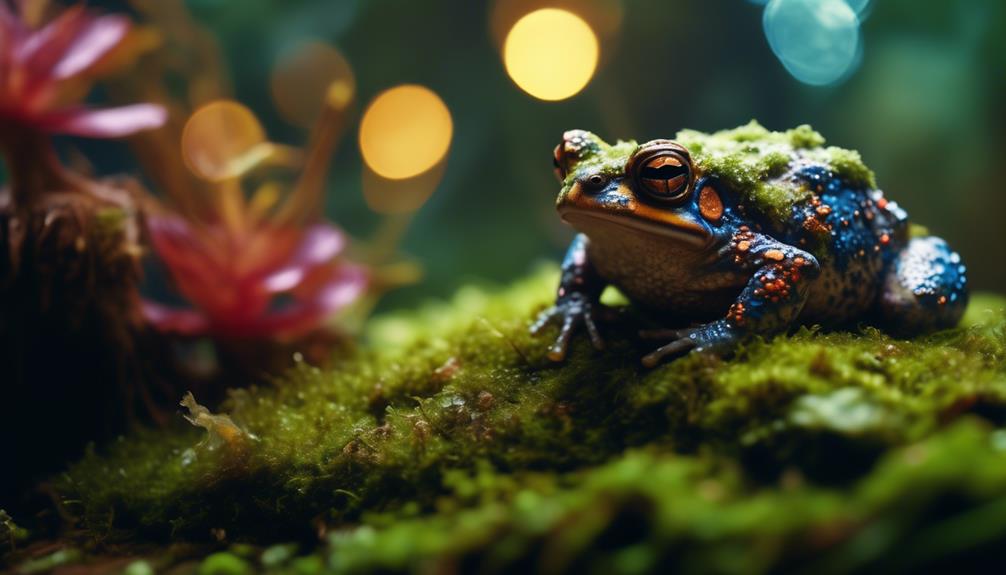
The Colorado River toad, commonly known as the psychedelic toad, has captivated the interest of scientists, cultural enthusiasts, and individuals seeking alternative experiences. Recognized for its potent venom and potential psychotropic properties, this extraordinary amphibian holds a significant place in both biological and cultural realms.
As we delve into the depths of its existence, we discover a creature that is not only powerful but also sacred, with a history and allure that extends far beyond its physical appearance. In this discussion, we will explore the fascinating attributes and cultural significance of the psychedelic toad, shedding light on its mystical and potentially transformative properties.
Key Takeaways
- The Colorado River toad, also known as the Psychedelic Toad, is the largest toad in the United States and has unique physical characteristics such as a bulging parotoid gland and a large circular ear drum.
- The toad is found in the lower Colorado River and Gila River catchment areas, as well as in certain parts of Mexico, and inhabits desert and semi-arid areas.
- There are legal issues and conservation concerns surrounding the toad, with restrictions on possession and collection in certain states and the listing of the species as threatened in New Mexico and California.
- The toad’s venom contains substances that can be toxic to humans and has been used in traditional medicine and rituals for its psychoactive effects, leading to its popularity in the psychedelic community and increased interest from researchers.
Description and Biology of Colorado River Toad
The Colorado River toad, also known as Incilius alvarius, is a species of toad that is native to the United States and Mexico. It is the largest toad in the United States, apart from the non-native cane toad.
The toad has a smooth, leathery skin and is usually olive green or mottled brown in color. It possesses a bulging kidney-shaped parotoid gland behind its large golden eye, as well as a large circular pale green area, which serves as its ear drum. The Colorado River toad has toxic secretions from various glands on its body.
It actively forages and feeds on invertebrates, lizards, small mammals, and other amphibians. The breeding season for this species is between May and September, coinciding with greater rainfalls. The toad lays its eggs in ponds, slow-moving streams, temporary pools, or man-made structures.
It can be found in both desert and semi-arid areas, often inhabiting streams, springs, canals, drainage ditches, and even rodent burrows. The Colorado River toad is nocturnal and has a lifespan ranging from 2 to 4 years.
Distribution and Habitat of Colorado River Toad
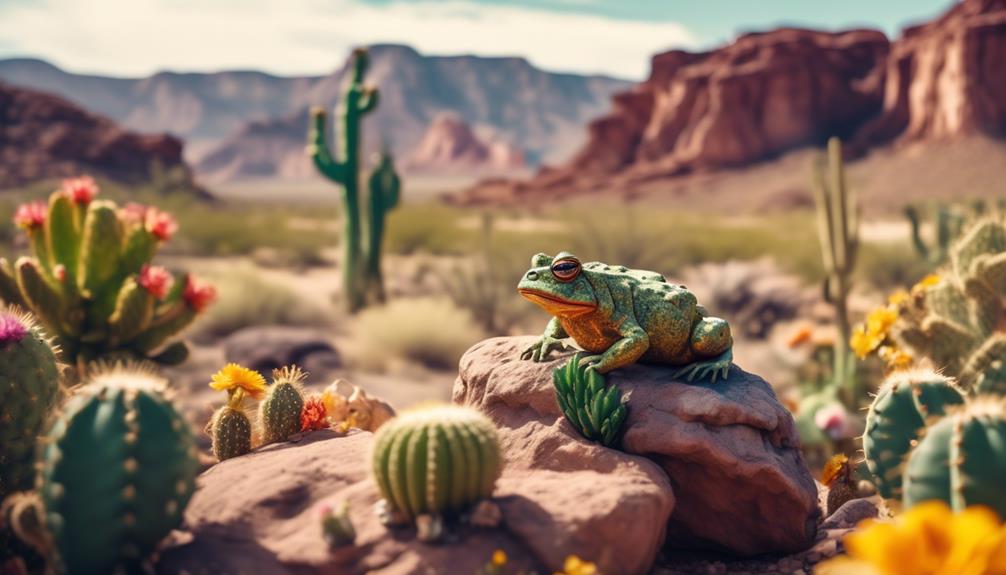
Native to the United States and Mexico, the Colorado River toad, also known as Incilius alvarius, can be found in a range of habitats and distributions.
In the United States, it is primarily found in the lower Colorado River and Gila River catchment areas.
It is also found in the states of Sonora, Sinaloa, and Chihuahua in Mexico.
The Colorado River toad inhabits both desert and semi-arid areas, and can be found in various water sources such as streams, springs, canals, drainage ditches, and under water troughs.
It often makes its home in rodent burrows and is nocturnal in nature.
The distribution of the Colorado River toad showcases its adaptability to different environments within its range.
Legal Issues and Conservation of Colorado River Toad
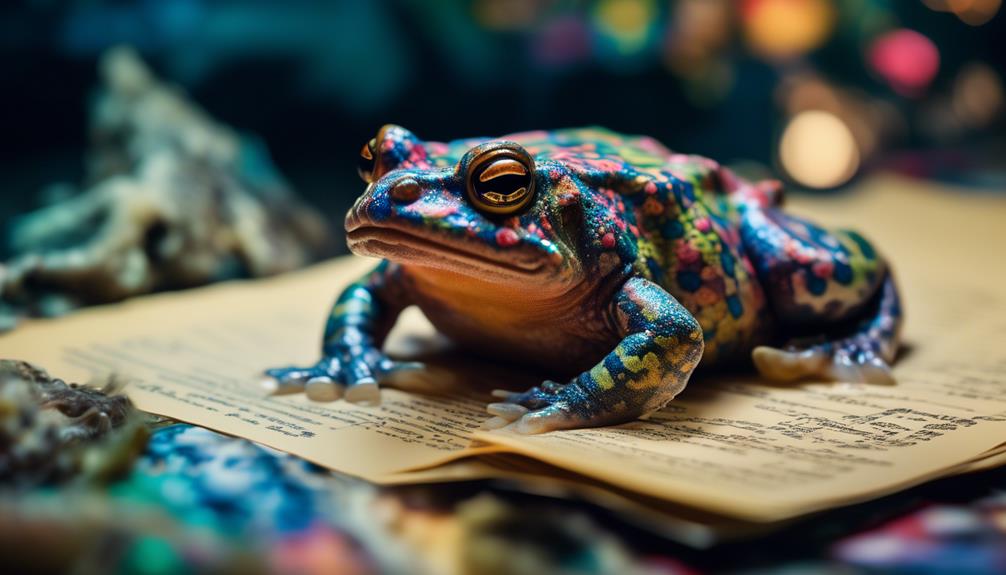
Legal regulations and conservation efforts play a crucial role in protecting the Colorado River toad, also known as Incilius alvarius, and its natural habitats. The possession and recreational use of the toad’s secretions, which contain the psychedelic compound bufotenin, is illegal in California. In Arizona, it is legal to catch up to 10 toads with a fishing license, but possession with the intent to use the secretions for smoking can result in criminal charges. The toad is protected in California, Arizona, and New Mexico, where it is illegal to remove them from their natural habitats. The Arizona Game and Fish Department has implemented regulations prohibiting the transport, sale, and display of the toad within the state. These legal measures aim to prevent overcollection and the potential collapse of the toad’s population.
| Legal Issues and Conservation of Colorado River Toad | |
|---|---|
| Legal Regulations | Conservation Efforts |
| – Bufotenin is outlawed in California since 1970. | – The toad is protected in California, Arizona, and New Mexico. |
| – Possession of toad secretions for recreational use is illegal. | – The Arizona Game and Fish Department prohibits the export, transport, possession, sale, and display of the toad within the state. |
| – Possession of toads with intent to smoke secretions can lead to criminal charges in Arizona. | – Conservation measures aim to prevent overcollection and population collapse. |
| – Removing toads from California, Arizona, and New Mexico is illegal. | – Breeding in captivity may help reduce collection pressure and potential diseases. |
| – Synthetic forms of the drug may reduce overcollection and protect wild populations. |
Toad Venom Poisoning and Health Risks
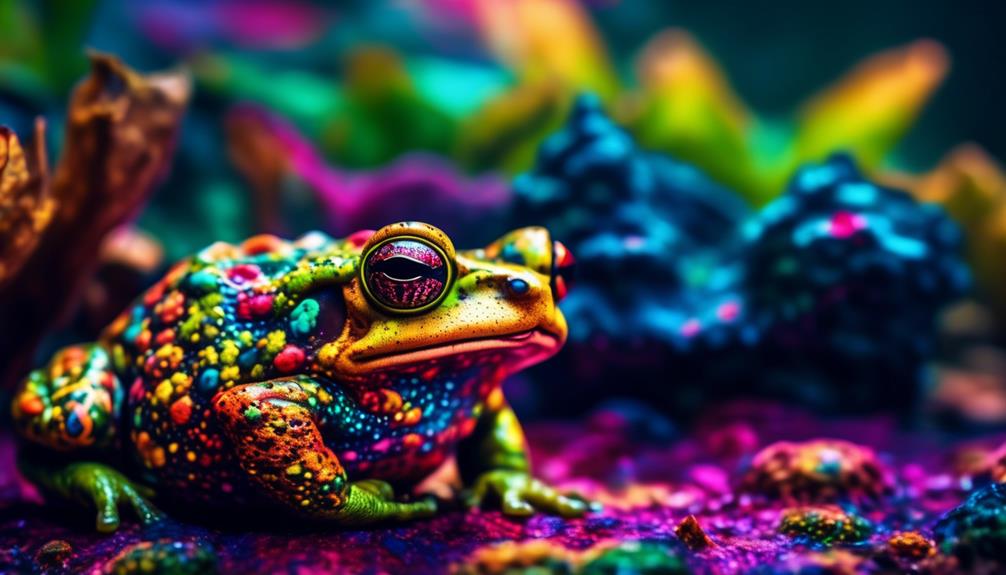
What are the potential health risks associated with toad venom poisoning? Toad venom contains substances that can be toxic to humans and ingesting it can have serious health consequences, including death.
Here are three important health risks to be aware of:
- Toxicity: Toad venom poisoning can resemble digoxin toxicity, a condition characterized by symptoms like nausea, vomiting, irregular heart rhythm, and even cardiac arrest. Prompt medical treatment is necessary in such cases.
- Lethal ingestion: There have been reported cases of lethal ingestion of toad venom. The toxic substances present in the venom can have severe effects on the respiratory and cardiovascular systems, leading to fatal outcomes.
- Misuse and consequences: Toad venom has been used in traditional medicine and as purported aphrodisiacs. However, ingesting toad venom for recreational purposes can have serious health risks and can even be life-threatening. It is important to understand the potential dangers and avoid the misuse of this powerful substance.
Cultural Significance and Psychotropic Uses

The cultural significance and psychotropic uses of the Colorado River toad have garnered increased attention and interest from researchers and enthusiasts. This unique toad, also known as the Sonoran Desert toad or the Bufo alvarius, has long been associated with hallucinogenic properties and has been used in traditional rituals by various indigenous groups. The toad’s secretion contains substances such as 5-MeO-DMT and bufotenin, which can induce psychoactive effects when smoked or ingested. The toad has been depicted in ancient iconography and holds cultural significance in certain regions. Its popularity in the psychedelic community has led to increased interest and demand. To provide a clearer understanding of its significance, the following table highlights the cultural and psychotropic uses of the Colorado River toad:
| Cultural Significance | Psychotropic Uses | Research |
|---|---|---|
| Traditional rituals | Hallucinogenic effects | Therapeutic potential |
| Symbolic representation | Spiritual experiences | Safety and dosage studies |
| Indigenous beliefs | Personal growth and enlightenment | Chemical composition analysis |
| Historical references | Shamanic practices | Ethnobotanical exploration |
| Art and literature | Psychedelic exploration | Conservation efforts |
This table illustrates the multifaceted nature of the Colorado River toad’s cultural and psychotropic significance. It reflects the wide range of uses and areas of interest that have attracted researchers and enthusiasts alike. Through further exploration and research, a deeper understanding of the toad’s cultural significance and psychotropic potential can be gained.
Size, Color, and Physical Features
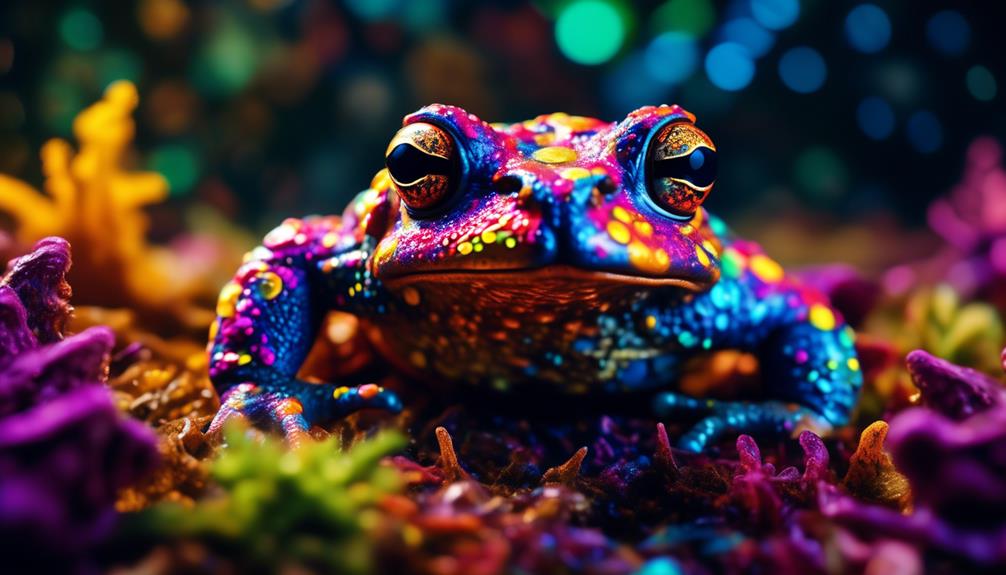
The Colorado River toad, also known as the Sonoran Desert toad or Bufo alvarius, exhibits notable characteristics in terms of its size, color, and physical features. Here are three key aspects that make this toad stand out:
- Impressive size: The Colorado River toad is the largest toad in the United States, apart from the non-native cane toad. Its size contributes to its striking presence in the wild.
- Striking coloration: With an olive green or mottled brown color, the Colorado River toad’s appearance blends seamlessly with its desert and semi-arid habitat. This natural camouflage allows it to remain well-hidden from predators.
- Unique physical features: One notable physical feature of the Colorado River toad is its bulging kidney-shaped parotoid gland, located behind its large golden eye. Additionally, it has a large circular pale green area, which serves as its ear drum. These features add to its distinctive appearance and contribute to its survival in its natural environment.
These characteristics contribute to the allure and mystique surrounding the Colorado River toad, making it a truly fascinating creature.
Breeding Behavior and Reproduction
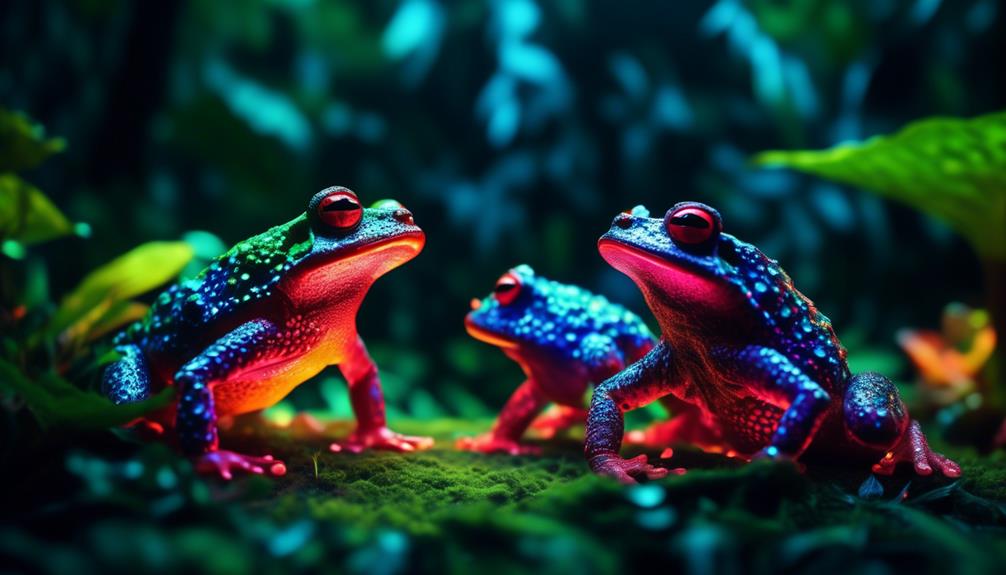
The breeding behavior and reproduction of the Colorado River toad reveal fascinating adaptations and strategies for successful reproduction.
Breeding season for the toad typically begins in July during the rainy season, when conditions are optimal for egg-laying.
The toads lay their eggs in ponds, slow-moving streams, temporary pools, or man-made structures. The eggs, which are encased in a long single tube of jelly, have a diameter of approximately 1.6mm.
Female toads can lay up to 8,000 eggs, ensuring a high chance of survival for their offspring.
However, the breeding habitats of the Colorado River toad have been recently altered in south-central Arizona, potentially affecting their reproductive success.
Understanding the breeding behavior and reproduction of this toad species is crucial for its conservation and preservation in its natural habitat.
Diet and Feeding Habits
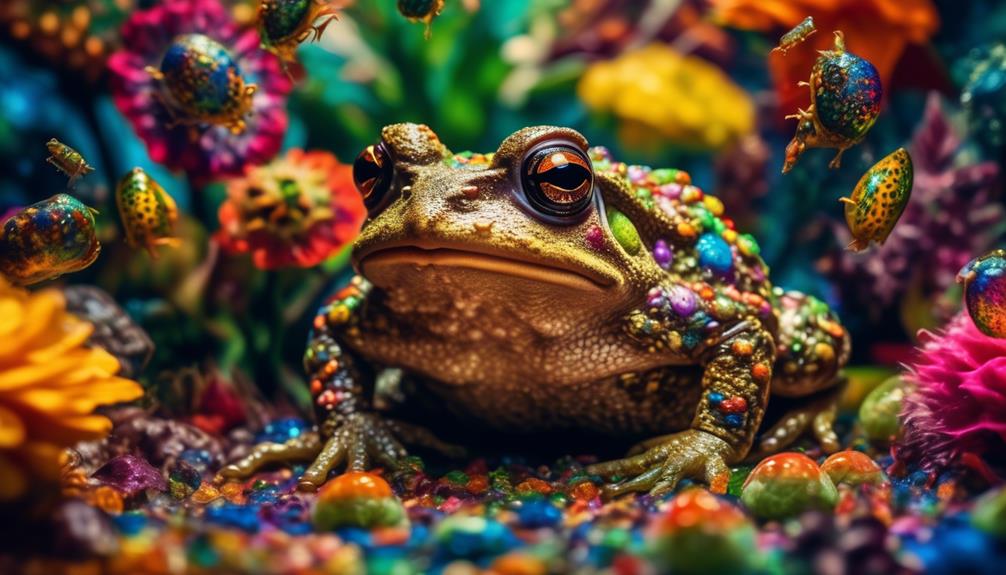
With a thorough understanding of the Colorado River toad’s reproductive strategies, it is essential to explore its dietary preferences and feeding habits in order to gain a comprehensive understanding of its ecological role. Here are three intriguing facts about the diet and feeding habits of the Colorado River toad:
- Generalist Feeder: The Colorado River toad is an opportunistic feeder and has a broad diet. It actively forages and feeds on a variety of prey, including invertebrates, lizards, small mammals, and other amphibians. This flexibility in its diet allows the toad to adapt to different food availability in its habitat.
- Predatory Behavior: This toad species exhibits predatory behavior, actively hunting and capturing its prey. It possesses a specialized feeding mechanism, using its sticky tongue to snatch and consume its prey. This predatory behavior contributes to the toad’s role in controlling populations of small invertebrates and maintaining ecological balance.
- Nocturnal Feeding: The Colorado River toad is primarily nocturnal, meaning it is most active during the night. This nocturnal behavior is advantageous for its feeding habits as it allows the toad to avoid extreme daytime temperatures and potential predators, while also targeting prey that is more active during the night.
Lifespan and Taxonomic Affinities
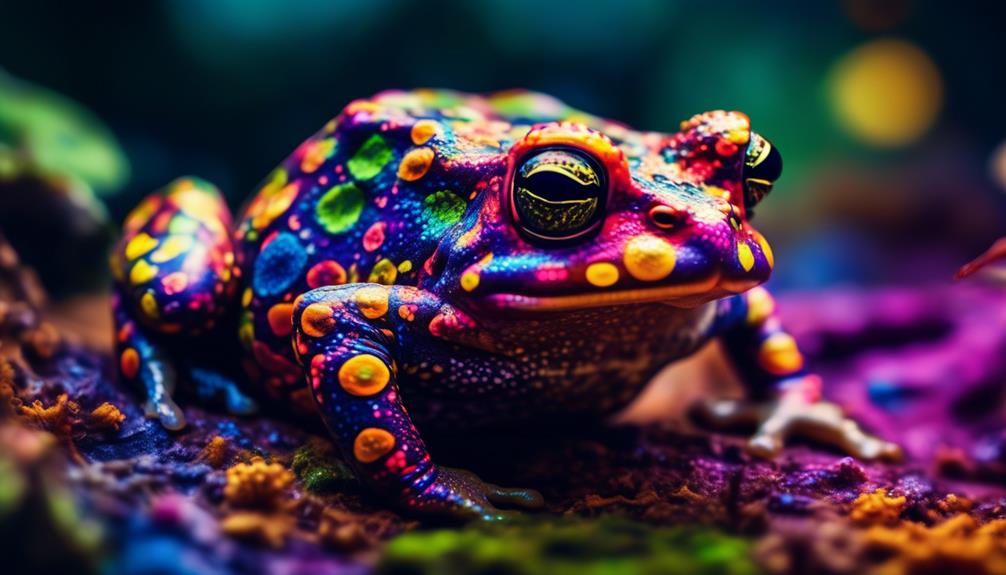
Lifespan and taxonomic affinities of the Colorado River toad remain subjects of ongoing scientific inquiry and research. The toad’s lifespan typically ranges from 2 to 4 years, although individual variations may occur. As for its taxonomic affinities, they remain unclear and continue to be a topic of investigation. To provide a clearer understanding, the following table presents the taxonomic classification of the Colorado River toad:
| Kingdom | Animalia |
|---|---|
| Phylum | Chordata |
| Class | Amphibia |
| Order | Anura |
| Family | Bufonidae |
| Genus | Incilius |
| Species | alvarius |
Threats and Conservation Efforts
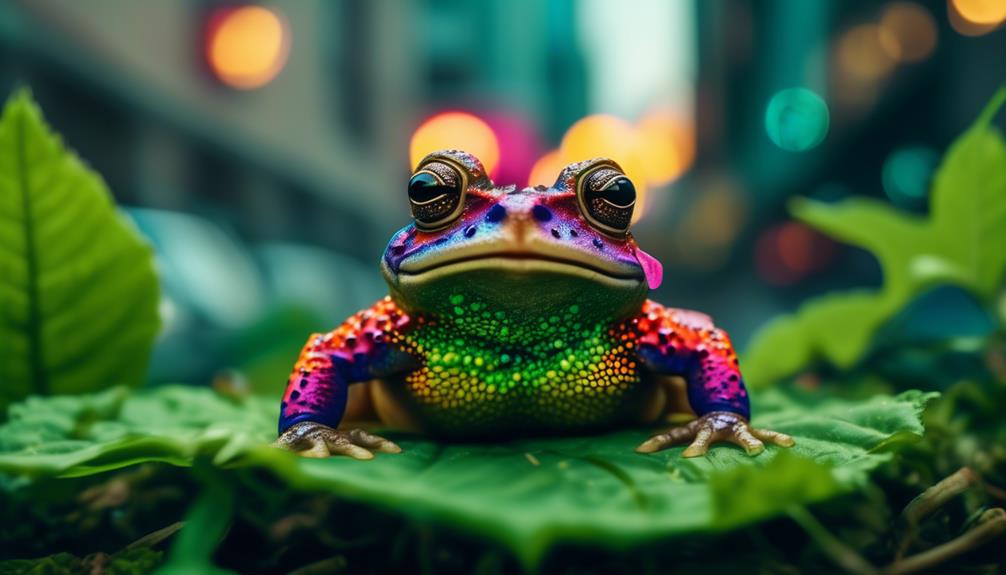
Ongoing scientific inquiry regarding the lifespan and taxonomic affinities of the Colorado River toad has shed light on the numerous threats facing this unique amphibian species and the conservation efforts implemented to protect its population.
Habitat loss: The expansion of urbanization and agriculture has resulted in the destruction and degradation of the Colorado River toad’s natural habitat. Wetland drainage, water diversions, and pollution have further exacerbated the loss of suitable breeding and foraging grounds.
Overcollection: The popularity of the Colorado River toad in the psychedelic community has led to an increase in its collection for its psychoactive secretions. This overcollection not only disrupts the toad’s natural populations but also puts stress on the individuals during the milking process.
Pollution and climate change: The Colorado River toad is highly sensitive to environmental changes, including water pollution and shifts in temperature and rainfall patterns. Pollution from pesticides, herbicides, and industrial waste can directly harm the toad, while climate change can alter breeding seasons and affect the availability of food sources.
Conservation efforts have been implemented to address these threats. These include the protection and restoration of critical habitats, public outreach and education programs, and the regulation of toad collection and trade.
Additionally, research is being conducted to better understand the toad’s biology and ecology, which will inform conservation strategies and management practices to ensure the long-term survival of this powerful and sacred creature.
Toad’s Natural Habitat and Behavior
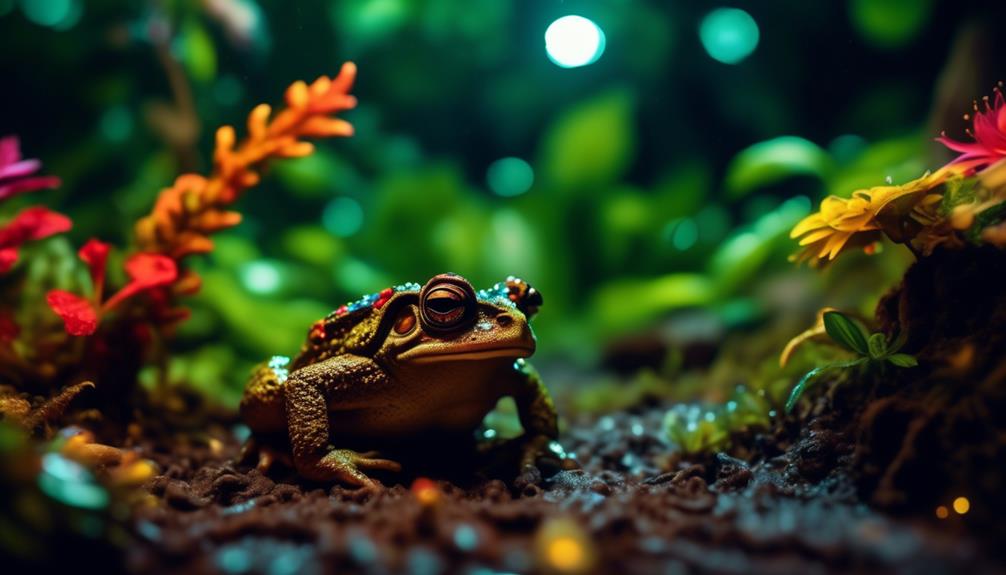
The natural habitat and behavior of the Colorado River toad provide insight into its ecological role and adaptations. Found in the lower Colorado River and Gila River catchment areas in the United States, as well as in Sonora, Sinaloa, and Chihuahua in Mexico, this toad inhabits both desert and semi-arid areas. It can be found in streams, springs, canals, drainage ditches, and under water troughs.
The Colorado River toad often makes its home in rodent burrows and is nocturnal. In terms of behavior, it actively forages and feeds on invertebrates, lizards, small mammals, and other amphibians. Its breeding season typically occurs from May to September, coinciding with greater rainfall. The eggs of the Colorado River toad are laid in ponds, slow-moving streams, temporary pools, or man-made structures.
Legal Restrictions and Consequences

Enforcement of legal restrictions and consequences surrounding the Colorado River toad’s possession and use is crucial for ensuring public safety and the conservation of this unique species. Here are three important points to consider:
- Criminal charges: Possessing the secretions of the Colorado River toad for recreational purposes can lead to criminal charges in certain jurisdictions. For example, in California, bufotenin, a substance found in the toad’s secretions, has been outlawed since 1970.
- State regulations: Different states have varying laws regarding the possession and transportation of the Colorado River toad. In Arizona, for instance, it is legal to bag up to 10 toads with a fishing license, but possessing the toad with the intent to smoke its secretions can result in criminal charges.
- Conservation concerns: Removing the Colorado River toad from its natural habitat is illegal in states like California, Arizona, and New Mexico. Collecting these toads can cause stress and potentially lead to a collapse in their population. It is important to protect and conserve this species to maintain ecological balance.
Toad’s Historical and Cultural Significance

To fully understand the Colorado River toad, it is important to explore its historical and cultural significance, which has played a significant role in shaping its reputation and attracting attention from various communities. The toad has been depicted in ancient iconography and has cultural significance in certain regions. Its secretion, known for inducing psychoactive effects, has been used in traditional rituals and has been associated with hallucinogenic properties. This has led to increased interest and demand in the psychedelic community. The toad’s unique characteristics and effects have also attracted attention from researchers and enthusiasts. To further illustrate the historical and cultural significance of the Colorado River toad, the following table provides examples of its representation and symbolism:
| Historical and Cultural Significance of Colorado River Toad |
|---|
| Ancient iconography |
| Traditional rituals |
| Hallucinogenic properties |
Frequently Asked Questions
What Is the Legal Status of the Colorado River Toad and Its Secretions in California?
The possession of the secretions of the Colorado River toad, specifically Bufotenin, for recreational purposes is outlawed in California. Removing the Colorado River toad from California, Arizona, and New Mexico is also illegal.
How Can Collecting Large Numbers of Colorado River Toads Impact Their Population?
Collecting large numbers of Colorado River toads can have a detrimental impact on their population. It can lead to a collapse in their numbers, disrupt breeding patterns, attract predators, and spread diseases in the wild.
What Are the Health Risks Associated With Ingesting Toad Venom?
Toad venom contains toxic substances that can be harmful to humans. Ingesting toad venom can lead to serious health risks, including potential toxicity similar to digoxin poisoning and even death. Caution should be exercised when dealing with toad venom.
How Has the Colorado River Toad Been Used in Traditional Rituals and Ceremonies?
The Colorado River toad has been used in traditional rituals and ceremonies due to its association with hallucinogenic properties. Its secretion contains substances that induce psychoactive effects, making it culturally significant in certain regions. This has led to increased interest and demand in the psychedelic community.
What Are the Potential Consequences of Removing the Colorado River Toad From Its Natural Habitat in Arizona, New Mexico, and California?
The potential consequences of removing the Colorado River toad from its natural habitat in Arizona, New Mexico, and California include the illegal nature of the action, stress to the toads during the milking process, population collapse, and the spread of diseases in the wild.
Are Colorado River toads also considered sacred in any cultures?
The fascinating world of American toads includes the Colorado River toad, which holds cultural significance for various indigenous tribes. In some Native American cultures, these toads are considered sacred and are used in traditional healing ceremonies. Their presence in spiritual rituals reflects the deep reverence for wildlife in these communities.
Conclusion
In conclusion, the Colorado River toad holds both biological and cultural significance. Its distinct appearance and toxic secretions make it a unique creature. However, it faces legal restrictions and conservation concerns due to misuse and overcollection. The toad’s venom is toxic to humans and is of interest for its potential psychotropic properties.
The Colorado River toad’s unique attributes and cultural relevance make it a powerful and sacred creature. Efforts are needed to protect its natural habitat and ensure its survival.

